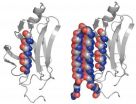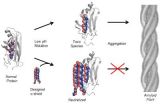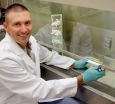(Press-News.org) There is no cure for Alzheimer's disease and other forms of dementia, but the research community is one step closer to finding treatment.
University of Washington bioengineers have a designed a peptide structure that can stop the harmful changes of the body's normal proteins into a state that's linked to widespread diseases such as Alzheimer's, Parkinson's, heart disease, Type 2 diabetes and Lou Gehrig's disease. The synthetic molecule blocks these proteins as they shift from their normal state into an abnormally folded form by targeting a toxic intermediate phase.
The discovery of a protein blocker could lead to ways to diagnose and even treat a large swath of diseases that are hard to pin down and rarely have a cure.
"If you can truly catch and neutralize the toxic version of these proteins, then you hopefully never get any further damage in the body," said senior author Valerie Daggett, a UW professor of bioengineering. "What's critical with this and what has never been done before is that a single peptide sequence will work against the toxic versions of a number of different amyloid proteins and peptides, regardless of their amino acid sequence or the normal 3-D structures."
The findings were published online this month in the journal eLife.
More than 40 illnesses known as amyloid diseases – Alzheimer's, Parkinson's and rheumatoid arthritis are a few – are linked to the buildup of proteins after they have transformed from their normally folded, biologically active forms to abnormally folded, grouped deposits called fibrils or plaques. This happens naturally as we age, to a certain extent – our bodies don't break down proteins as quickly as they should, causing higher concentrations in some parts of the body.
Each amyloid disease has a unique, abnormally folded protein or peptide structure, but often such diseases are misdiagnosed because symptoms can be similar and pinpointing which protein is present usually isn't done until after death, in an autopsy.
As a result, many dementias are broadly diagnosed as Alzheimer's disease without definitive proof, and other diseases can go undiagnosed and untreated.
The molecular structure of an amyloid protein can be only slightly different from a normal protein and can transform to a toxic state fairly easily, which is why amyloid diseases are so prevalent. The researchers built a protein structure, called "alpha sheet," that complements the toxic structure of amyloid proteins that they discovered in computer simulations. The alpha sheet effectively attacks the toxic middle state the protein goes through as it transitions from normal to abnormal.
The structures could be tailored even further to bind specifically with the proteins in certain diseases, which could be useful for specific therapies.
The researchers hope their designed compounds could be used as diagnostics for amyloid diseases and as drugs to treat the diseases or at least slow progression.
"For example, patients could have a broad first-pass test done to see if they have an amyloid disease and then drill down further to determine which proteins are present to identify the specific disease," Daggett said.
The research team includes Gene Hopping, Jackson Kellock and James Bryers of UW bioengineering; Gabriele Varani and Ravi Pratap Barnwal of UW chemistry; Peter Law, a former UW graduate student; and Byron Caughey of the National Institutes of Health's Rocky Mountain Laboratories.
Working with the UW's Center for Commercialization, they have a patent on one compound and have submitted an application to patent the entire class of related compounds.
This research began a decade ago in Daggett's lab when a former graduate student, Roger Armen, first discovered this new secondary structure through computer simulations. Daggett's team was able to prove its validity in recent years by designing stable compounds and testing their ability to bind toxic versions of different amyloid proteins in the lab.
INFORMATION:
The research was funded by the National Institutes of Health (General Medicine Sciences), the National Science Foundation, the Wallace H. Coulter Foundation and Coins for Alzheimer's Research Trust.
For more information, contact Daggett at daggett@uw.edu.
New protein structure could help treat Alzheimer's, related diseases
2014-07-28
ELSE PRESS RELEASES FROM THIS DATE:
Green spaces found to increase birth weight -- Ben-Gurion U. researcher
2014-07-28
BEER-SHEVA, ISRAEL, July 28, 2014...Mothers who live near green spaces deliver babies with significantly higher birth weights, according to a new study, "Green Spaces and Adverse Pregnancy Outcomes" published in the journal, Occupational and Environmental Medicine.
A team of researchers from Israel and Spain, including Ben-Gurion University of the Negev (BGU), evaluated nearly 40,000 single live births from a registry birth cohort in Tel Aviv, Israel to determine the impact of green surroundings during pregnancy and birth outcomes.
"We found that that overall, an increase ...
Strategies identified to improve oral contraceptive success with obese women
2014-07-28
PORTLAND, Ore. – The findings of a new study suggest two ways to effectively address the problem that birth control pills may not work as well in obese women, compared to women of a normal body mass index.
Birth control pills are a one-size-fits-all method, researchers say, but as the population has increased in weight, concern has grown about how well the pill works for obese women. Studies have consistently found that obesity has a negative impact on drug levels in the body, which may in turn affect how well the pill prevents pregnancy.
"Birth control pills have ...
How sweet it is
2014-07-28
A powerful new tool that can help advance the genetic engineering of "fuel" crops for clean, green and renewable bioenergy, has been developed by researchers with the U.S. Department of Energy (DOE)'s Joint BioEnergy Institute (JBEI), a multi-institutional partnership led by Lawrence Berkeley National Laboratory (Berkeley Lab). The JBEI researchers have developed an assay that enables scientists to identify and characterize the function of nucleotide sugar transporters, critical components in the biosynthesis of plant cell walls.
"Our unique assay enabled us to analyze ...
Scissoring the lipids
2014-07-28
A new strategy which enables molecules to be disconnected essentially anywhere, even remote from functionality, is described by researchers from the University of Bristol in Nature Chemistry today. The method is now being developed to explore the possibility of creating a tuberculosis (TB) vaccine.
The organic synthesis strategy, developed by Professor Varinder Aggarwal and Dr Ramesh Rasappan in the School of Chemistry, involves a new method for combining smaller fragments together in which there is no obvious history in the product of their genesis.
The paper describes ...
Study helps compare risks of treatments for early esophageal cancer
2014-07-28
CHICAGO – A new study, published in the July, 2014, issue of the Journal of the National Cancer Institute by Northwestern Medicine® researchers, sheds new light on the risks associated with the growing popularity of endoscopic resection in the treatment of localized, early-stage esophageal cancer. Researchers found that the more traditional surgical resection, while more invasive, provided significantly better outcomes with an 87.6 percent five-year survival rate for patients than endoscopic resection, which had a 76 percent five-year survival rate. The study, "Treatment ...
Satellite sees Genevieve's remnants chased by 2 more systems
2014-07-28
Tropical Storm Genevieve may be a remnant low pressure area but there's still a chance it could make a comeback. Meanwhile, GOES-West satellite imagery showed there are two developing low pressure areas "chasing" Genevieve to the east. NOAA's Central Pacific Hurricane Center has suddenly become very busy tracking these three areas.
NASA/NOAA's GOES Project at NASA's Goddard Space Flight Center in Greenbelt, Maryland provided an infrared image of the Central and Eastern Pacific on July 28 that showed Genevieve southeast of Hawaii, and two other low pressure areas behind ...
Booming mobile health app market needs more FDA oversight for consumer safety, confidence
2014-07-28
Dallas (SMU) — Smart phones and mobile devices are on the cusp of revolutionizing health care, armed with mobile health ("mHealth") apps capable of providing everything from cardiac measurements to sonograms.
While tremendous potential exists to broaden access to medical treatment and control costs, several health law experts say in a just-published New England Journal of Medicine (NEJM) report that more oversight is needed by the U.S. Food and Drug Administration (FDA) to ensure consumer confidence and safety. Out of some 100,000 mHealth apps on the market, only about ...
Two-step decision tree analysis helps inform updates of RT best practices, quality standards
2014-07-28
Fairfax, Va., July 28, 2014—A two-step decision tree analysis, incorporating Donabedian's model, is a feasible process to evaluate and distill the many available quality standards, guidelines, recommendations and indicators in order to update national and international quality standards for radiation therapy, according to a study published in the July-August 2014 issue of Practical Radiation Oncology (PRO), the official clinical practice journal of the American Society for Radiation Oncology (ASTRO).
Guidelines, recommendations and indicators may be utilized to develop ...
Researchers identify potential biomarker for AD
2014-07-28
(Boston)-- Researchers from Boston University School of Medicine (BUSM) report variants in a new gene, PLXNA4, which may increase the risk of developing Alzheimer's disease (AD). The discovery of this novel genetic association may lead to new drug treatment options that target PLXNA4 specifically. These findings appear in the Annals of Neurology.
AD is the most frequent age-related dementia affecting 5.4 million Americans including 13 percent of people age 65 and older, and more than 40 percent of people age 85 and older. Genetic factors account for much of the risk for ...
Researcher using next-generation sequencing to rapidly identify pathogens
2014-07-28
MANHATTAN, Kansas — He calls himself the bug hunter, but the target of his work consists of viruses that can only be found and identified with special methods and instruments. Benjamin Hause, an assistant research professor at the Kansas State Veterinary Diagnostic Laboratory at Kansas State University, recently published an article about one of his discoveries, porcine enterovirus G, which is an important find in the United States.
"We had isolated a virus in cells, but didn't know what it was," Hause said. "We used next-generation sequencing to identify it, and it turned ...




